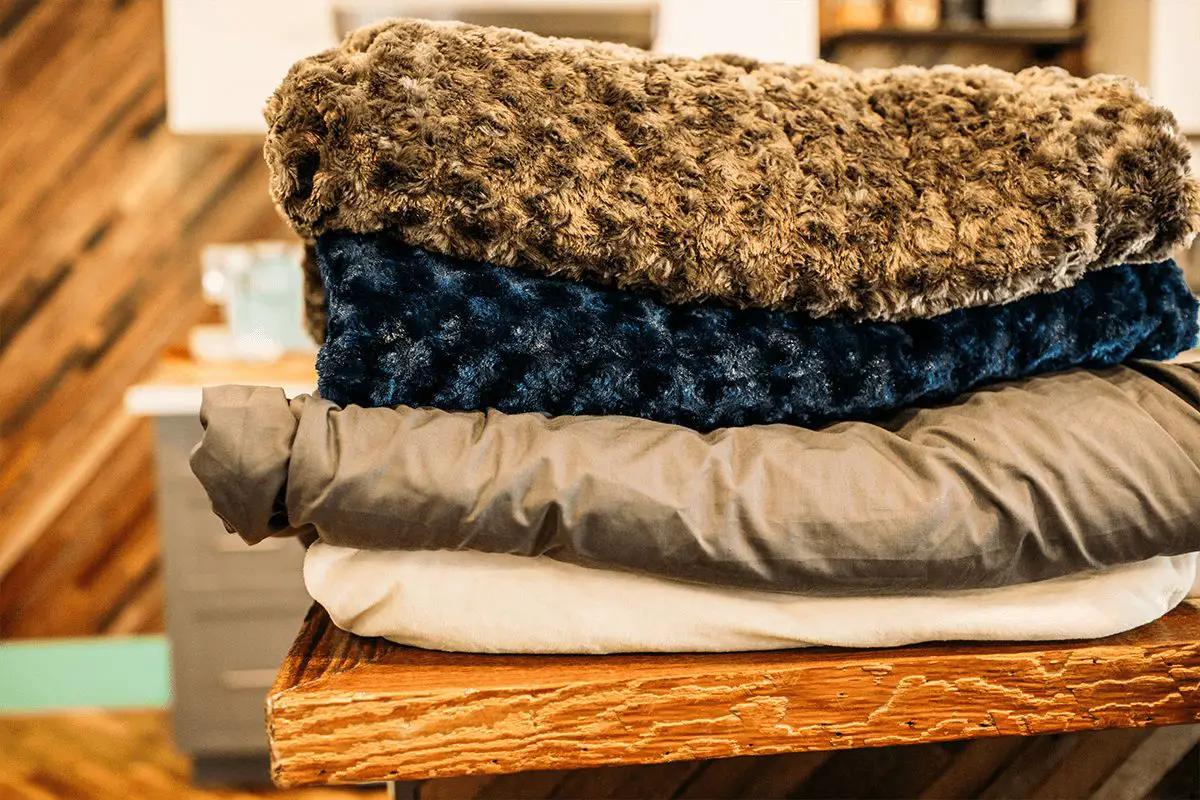Weighted blankets have exploded in popularity of late. They’re used therapeutically for a variety of issues including sensory processing disorder, anxiety, depression, autism, insomnia, ADHD and simply getting a better night’s sleep. In short, the blankets use deep pressure touch simulation therapy (DPTS), which is similar to that of swaddling a baby. While light touches can alert the nervous system, deep pressure—like a deep tissue massage or a strong hug—can have a relaxing, calming effect on the body. Yet despite the recent hype surrounding this concept and myriad companies touting their versions, the first commercially available weighted blanket has been around for over 20 years—and may still be the best.
The original weighted blanket, “The Magic Weighted Blanket,” was invented by California native, Keith Zivalich, in 1998. I was lucky enough to speak with Keith about his idea for a weighted blanket and how and why this concept came to be.
GLR: How did you come up with the idea for the weighted blanket and when?
KZ: In 1997, I was driving on a family vacation and my daughter, about 10 at the time, put a Beanie Baby named “Pugsly” on my shoulder to keep me company while I drove. I noticed how the weight of the stuffed animal made it hug my shoulder. I thought, “Wouldn’t it be cool if there was a blanket filled with these same ‘beanies.’ It would be the blanket that hugs you back.” I immediately thought I would call this new type of blanket a “Beanie Blanket.” At the time, there was no such thing as a weighted blanket. My wife made a prototype “beanie blanket” and I showed it to our neighbors who had small children. They all looked at it, kind of perplexed, and said they probably wouldn’t use this on their kids. I had also shown it to a family friend who was a special needs teacher. She took it to her class and used it with her students. That night she told me that she needed more “beanie blankets.” Lots more.
After hearing how the blanket helped these children with special needs, I knew the idea was going to be huge and that I needed to protect it. So, around 2002, I decided to file a patent. Not having the money to hire a patent attorney, I filed the application myself. After a year, I got a call from the patent examiner, who informed me that my application was not unique enough and was being denied. I thanked him and hung up. Then, in 2018, I came up with another new product idea (more on that later). This time I hired a patent attorney. He warned me that most patent applications are denied the first time around because they want you to argue its uniqueness. The patent for my new idea, like the weighted blanket idea, was denied for not being unique enough. This time, we argued and demonstrated that it was in fact unique, and a patent was granted. Had I done that for the weighted blanket, I am almost positive I would have a patent on that as well.
GLR: Was anyone talking about the concept of weighted blankets back when you had your aha moment?
KZ: Not only was no one talking about weighted blankets at the time, no one had ever heard of a “weighted blanket.” I was calling my idea a “Beanie Blanket.” Since it was the first, I called my new business “The Original Beanie Blanket Company.” I sold my first blanket on December 8, 1998 to a friend in Idaho. This was to establish interstate commerce. Having done that, I then applied for a trademark. I was later contacted by Ty Corporation lawyers, who sent me a Cease and Desist Letter, letting me know that I could not use the word “Beanie.” So, I shortened our official corporate name to The Original Bean Blanket Company. I then searched for, and finally found, a company willing to make blankets for us. With six or so professionally made “bean blankets” in hand, I set up a small table at a local swap meet. There was lots of interest in my heavy blankets, but none were sold. Undaunted, I taught myself basic HTML skills and made our first ecommerce site. Next, I made small signs that I could place on the off-ramps of freeways near my home that read, “Need a hug?” That led to sale of my second blanket, and the start of my e-commerce entrepreneurship.
GLR: What is the general concept behind a weighted blanket? Why does more weight on our bodies help us relax and fall asleep quicker, relieve anxiety etc?
KZ: The weight of the blanket on the body creates a physiological reaction, similar to when a newborn baby is swaddled. This “compression” has a naturally calming effect, and is why our special needs teacher would often tightly hug her students to calm them down. Many of her students were Autistic and/or had Sensory Processing Disorder. These children often could not feel their own bodies in space, which caused them to be constantly on the move. This movement helped them to “feel” their body, but it was also disruptive and a detriment to learning and socializing. Known as Proprioceptive Input, the weight of the blanket helped send a signal to their brain letting them know that they could now feel their bodies when under the heavy blanket. This helped them to stop fidgeting and to relax. The feeling of being hugged is pleasant to everybody, not just those with special needs. When people (especially those with feelings of anxiety) get under a weighted blanket, the chemical called Serotonin is released in the body. This neurotransmitter creates a feeling of well-being and happiness. It’s why so many people actually enjoy the lead vest as the dentist. It’s why a hug feels good. And it’s this feeling that helps to calm the mind and body and promotes deeper sleep.
Research shows that deep pressure therapy (DPT)—the principle that weighted blankets are designed around—stimulates a cycle of reducing cortisol (the stress hormone) increasing the production of serotonin (the neurotransmitter that affects mood, digestion and sleep) and eventually melatonin (which is called the sleep hormone).
According to Applied Behavior Analysis Edu.org—an independent online resource for applied behavior analysts, “When you apply deep pressure to the body, the body switches from running its sympathetic nervous system to its parasympathetic nervous system. This is the so-called switch from ‘fight or flight’ to ‘rest and digest.’ When the parasympathetic nervous system takes over, your heart rate slows, muscles relax, and circulation improves. Your body produces endorphins, which are the “happy” hormones that make you feel amazing after a good run.
As deep pressure is applied to the body, the parasympathetic nervous system comes online, calming you and bringing a sense of well-being. In tandem with this change comes a release of dopamine and serotonin, the feel-good neurotransmitters of the brain. These hormones help with motivation, impulse control, attention, memory, social behavior, sleep, and digestion.”
Results of a study published in the Journal of the Formosan Medical Association, showed that participants undergoing wisdom tooth removal (which researchers identified as one of the most stressful medical procedures) who wore weighted blankets during the procedure had more activity in the part of the nervous system that is in control during times of low stress.
GLR: Weighted blankets, clothes and other weighted accessories have become very popular as a calming technique for children with sensory processing disorder, autistic spectrum disorders and even ADHD. Why is that?
KZ: It all comes back to the hug and compression. And it’s why, as newborns, we come out of a warm and safe environment inside the womb into a cold and over-stimulating new world, and immediately start to cry. Once we are swaddled and made to feel safe and comforted again, we slowly start to adapt to our new world. Weighted therapy blankets have the same effect. The warmth and gentle compression signals the release of serotonin and other neurotransmitters, which then enable us to enjoy a calming and tranquil cool down from a hard day.
Autism researcher, Temple Grandin, was a pioneer of compression therapy which she first observed being used when cows were held in place to receive their vaccinations. She noticed that when the cows were gently squeezed, they became calmer and docile. Dr. Grandin remembered how as a child, who herself had sensory processing disorder, being held or hugged often eased her anxiety but other times she felt confined or restricted. The therapy tool she developed worked by applying firm but gentle pressure throughout the body. Scientific studies have shown that such gentle contact stimulates the release of oxytocin—often called the hug or cuddle hormone produced by the hypothalamus.
GLR: Weighted blankets are also used by veterans with PTSD. What has been the feedback from our soldiers who use them and what sort of measures has Magic Weighted Blanket as a company to help them?
KZ: Because weighted blankets have demonstrated a naturally calming effect, they have become quite popular for the treatment of PTSD. We have sold blankets to the Veterans Administration going back ten years or more. We have also been donating blankets to veterans with PTSD who could not otherwise afford one. The response has been overwhelmingly positive. Most recently, we have partnered with The Friends of Ward 8. This is a volunteer group that works with the Veterans Administration’s PTSD program located in Ward 8 of the VA Hospital in Northampton, MA. Ward 8 provides 6-week program designed to help vets learn techniques for managing PTSD. It is our goal to provide a Magic Weighted Blanket to each vet going through the program.
Here is what one vet said, “Thank you so much for donating weighted blankets to the Ward 8 PTSD program. My name is Jake E. I am 32 years old and have struggled with PTSD since at least my Iraq deployment ended, which was a decade ago. I served as an army medic for 4 years overall. I have always had an animal in my bed with me but not while I was here and in-patient. This blanket made up for the difference in lack of having an animal to sleep on the bed with me. What a difference the blanket makes! It’s like getting a hug from someone all night long. The magic blanket has a pretty awesome feeling and has also helped me with my nightmares and the time it takes me to both fall asleep and stay asleep. Your blanket is very much appreciated and actively being put to good use every night.
Sincerely, Thank You!!!
Jake E.
GLR: What are some of the key differences between your blanket and others on the market?
–Made in Los Angeles, CA by highly trained and skilled machine operators.
–Most new weighted blankets on the market that are mass produced in China have removable duvet covers. After a few twists and turns in the washer and dryer, zippers often become misaligned and jammed.
–MWB designs one-piece blankets with a duvet cover securely sewn onto the inner liner, making them more durable & easier to wash and use than blankets with removable covers. Many of the competitors require the inner liner to be removed and hand washed.
–NO ASSEMBLY REQUIRED; NO zippers that will tear, NO ties that will break, NO inner liner that will bunch up, NO cover to attach.
–Only 100% new, BPA-free, non-toxic, hypo-allergenic polypropylene pellets are used inside the blankets.
–NO polyfill, which makes the blanket feel warm and stiff: NO Glass Beads which are the size and appearance of sugar grains and can work their way through seams, endangering pets and children.
–One size does NOT fit all. Most weighted blankets coming from China are only 72 inches long. This is too short for most men and some women as weighted blankets tend to work their way up, leaving the feet exposed.
GLR: Are you the only weighted blanked that is manufactured in the US and why is that important?
KZ: Up until about three years ago, there were about eight other weighted blanket manufacturers making their blankets in the US. Making a weighted blanket is very labor intensive. This makes our production costs relatively high. Since China has extremely low labor costs, they are able to “dump” their weighted blankets onto the US market at a ridiculously low cost. Today, there are many, many more US businesses starting up and buying their weighted blankets from China. My guess is there are 40 or more new businesses in the last two years alone selling Chinese-made weighted blankets. This is driving the prices down and making it much more difficult for these few remaining US-made businesses to stay in business.
GLR: What other fun facts would you like to share?
Being an entrepreneur is in my blood. Before the weighted blanket, there was the Dasher Basher (a punching bag that was placed on a car’s dashboard). Instead of flipping off the car in front of you, you took your aggression out on the Dasher Basher. Living in Los Angeles, everyone wants to be a writer or a director. I started a business that allowed people to become a producer. I called it, “What I Really Want to Do Is Produce.” It was a way for filmmakers to get financing before Crowd Funding. I started a company called “HDentertainment” that placed high definition plasma displays in the waiting area of restaurants. We went up in a Tony Roma’s and a Red Robin but could not come up with the financing to purchase a couple hundred plasma displays.
My latest invention is now patented, perfected and ready to bring more relaxation and rejuvenation into people’s lives. The “Zero Gravity Zen Bag” is the world’s first true zero gravity bean bag. The zero-gravity position was created by NASA to put astronauts in a more natural and comfortable position during lift off. In the zero-gravity position, you sit back at a 130-degree angle with your feet elevated above your heart. In this position you feel weightless, half-way between falling back and sitting up. It’s an ideal position for meditation, reading, playing video games, watching TV, and decompressing before crawling under a weighted blanket and sleeping. Check it out at www.zerogravityzen.com



